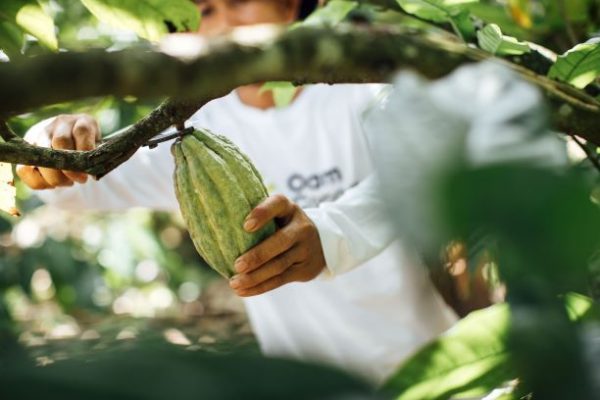In 2018, global chocolate consumption was recorded by the Innova Market research at 6 million metric tonnes, a 2.5% increase over the past five years, and there are no signs of this slowing down. Although Africa is typically the continent most associated with the cocoa industry as it produces the majority of the world’s cocoa supply, recent years have shown a huge increase in demand for cocoa in Asia.
In fact, Asia has become the second largest consumer of cocoa ingredients in the world and in particular, Indonesia has become the sixth largest producer of cocoa. Olam Cocoa has been operating in Indonesia since 1996 and is the country’s largest exporter of cocoa beans, establishing the company’s first cocoa sustainability initiative there in 2004. Since that time, USD$20 million in premiums have been paid to cocoa farmers and 5 million cocoa tree seedlings distributed.
Today Olam Cocoa has 65,500 Indonesian cocoa farmers across 6 provinces in sustainability programmes. Supplying resources for the best cocoa growing techniques based on leading plant science R&D, programmes aim to support livelihoods comparable to the farming of competing crops. Olam Cocoa also owns one of the largest cocoa plantations in Indonesia, located on Seram Island.
As a fully integrated cocoa business, the company is the leading originator of cocoa beans and a globally leading processor of cocoa powders, cocoa masses and cocoa butters.
Their 11 processing facilities (plus powder milling, blending and refining) have a capacity of 700,000 metric tonnes and are strategically based either in the main producing countries or in primary consumption markets to optimise transportation and environmental efficienciess. The European and North American markets are served by processing facilities in Germany, Spain, the Netherlands, the United Kingdom and the United States. The cocoa factory in Singapore serves the increasing demand for cocoa flavoured products in Asia.
Innovation and creativity are the driving forces behind each new cocoa ingredient the company brings to market. The six Cocoa Innovation Centres (CIC), with R&D professionals in Brazil, the Netherlands, Singapore, Spain, the United Kingdom and the United States, develop tailor-made cocoa ingredient solutions for chocolate, confectionery, dairy, biscuit and bakery, beverage, ice cream and dessert applications supported by comprehensive quality testing and precision processing.
The cocoa industry faces a number of complex challenges from poverty and child labour to deforestation. While these problems are deep-rooted, there is an opportunity for technology to have a positive impact and that is why we have developed a suite of digital solutions. One example is AtSource, our sustainable sourcing solution, which connects our customers directly to the source of supply at each stage of their product’s journey and tracks its social and environmental profile. This helps customers shape change on the ground and meet multiple sustainability targets, increasing resilience in supply chains.
Another example is the Olam and Farmers Information System (OFIS) which is a tool for cocoa farmers to optimise their yields and get the most from their farm. Using GPS mapping, it records data like size and age of trees and distance to social infrastructure. Farmers are issued with a personalised Farmer Development Plan (FDP). and can also receive payment through a mobile money wallet. To date 143,000 farms and 180,000 hectares of cocoa farmland have been mapped and 57,396 cocoa farmers have been issued with FDPs.
Olam Cocoa has been running cocoa sustainability programmes for over 15 years and it is an integral part of business. One example of their commitment to sustainability is the ‘One Farmer, One Acre’ project in Ghana. Many cocoa farmers are hesitant to do essential pruning to their farms as despite seeing demonstrations of the correct technique on Olam Cocoa demo plots, they still fear that they might get it wrong and risk their income. In order to build confidence and further skills, the project involves ‘pruning teams’ of young people helping their farming communities by pruning one corner (an acre) of the cocoa farm with the labour costs covered by Olam Cocoa.
Other sustainability efforts include the Living Landscape Policy (LLP). This supports a net-positive impact on the environment, meaning that we put in more into the food system than we take out. As part of the policy, they have developed the Forest Loss Risk Index (FLRI) which GPS maps our entire cocoa supplier network and highlights deforestation risk hotspots. We use this data to intervene and take action before deforestation happens. 100% of the network in Ghana Indonesia, Brazil and Cameroon has already been mapped, which has the second largest intact dense tropical rainforest in the world but is at a high risk of deforestation. The FLRI allows having a pre-emptive impact in cocoa growing regions like Cameroon to create sustainable livelihoods for cocoa farmers and protect forests for future generations.
Olam Cocoa operates in Ghana, Côte d’Ivoire, Nigeria, Cameroon, Tanzania and Uganda, however they also have a presence in every major cocoa growing region across the world. Collaboration with customers and partners to tackle the interlocked challenges facing the cocoa supply chain is the company’s key focus. Not only are they set for the 2020 goal of achieving 100% traceability from direct cocoa supply chain, but are committing to even more ambitious goals to help farmers prosper, cocoa communities to thrive and regenerate the living world.
The cocoa industry is constantly evolving, and Olam Cocoa is committed to being part of that change. They are leading players in a number of cross-sector alliances such as the Cocoa & Forests Initiative (CFI), in which they work with other cocoa companies and the governments of Ghana and Côte d’Ivoire to end deforestation and restore forest areas. Also, Olam was the first agri-business to take the initiative to become a member of the Fair Labor Association (FLA) to help strengthen processes and monitoring systems, as well as to provide transparency.








